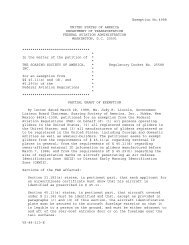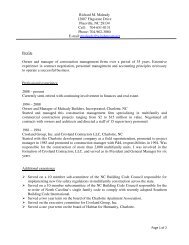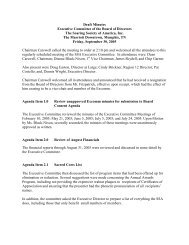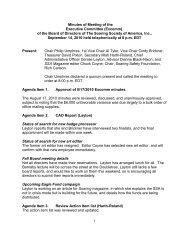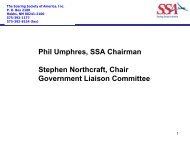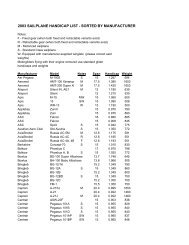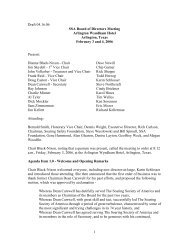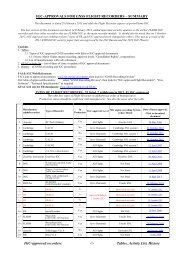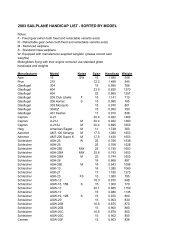1960 World Gliding Championships - Soaring Society of America
1960 World Gliding Championships - Soaring Society of America
1960 World Gliding Championships - Soaring Society of America
You also want an ePaper? Increase the reach of your titles
YUMPU automatically turns print PDFs into web optimized ePapers that Google loves.
were roughly divided into two<br />
groups: those that were able to get<br />
through these two areas, ended up in<br />
the 180-to-225 mile distance zone;<br />
and those that were unable to,<br />
averaged 60-to-125 miles. Dick Johnson<br />
did the best <strong>of</strong> our pilots, going<br />
112 miles for the 14th place <strong>of</strong> the<br />
day, while Schreder was unable to<br />
exceed the minimum distance on his<br />
second try and so got zero points.<br />
No points were given for flights<br />
under 20% <strong>of</strong> the maximum distance.<br />
Bikle tried to avoid a large down<br />
area, but was forced down after about<br />
65 miles trying to get around it and<br />
finished 32nd for the day. Tony<br />
Goodhart advised the Contest Officials<br />
that he had gone to over 20,000’<br />
in a cloud and asked that his points<br />
be disallowed. The Contest Officials<br />
said they would check all barographs<br />
for any obvious evidence <strong>of</strong> cloud<br />
flying and a few days later announced<br />
that there weren’t any additional<br />
ones.<br />
This day hurt all our pilots’<br />
chances considerably and the standings<br />
at the end <strong>of</strong> the second day<br />
were: In the Open: Makula and<br />
Popiel, 1st and 2nd, Hossinger 3rd,<br />
Schreder 15th and Johnson 19th. In<br />
the Standard Class: Witek lst, Fritz<br />
2nd, Resch 3rd and Bikle 25th.<br />
Since some pilots had gone further<br />
than 300 km, Tuesday was a rest<br />
day.<br />
Wednesday, June 8th, proved to<br />
be the outstanding day <strong>of</strong> the meet,<br />
from the point <strong>of</strong> view <strong>of</strong> outstanding<br />
flights, as well as international<br />
publicity. The day looked good as<br />
the pilots gathered together for the<br />
pilots’ meeting at 9. Dr. Kant, the<br />
chief meteorologist, predicted good<br />
conditions with a fairly strong SW<br />
wind. Free distance was chosen as<br />
the task, which, with a fairly strong<br />
wind, meant that flights would be<br />
One <strong>of</strong> the two U.S. entries in the open class, Dick Schreder‘s allmetal<br />
HP-8 sailplane. High wing loading was a disadvantage in weak<br />
conditions.<br />
Photo: Leonard A. Traufman<br />
SEPTEMBER ... <strong>1960</strong><br />
going to the NE corner <strong>of</strong> Germany.<br />
It was announced that if landings<br />
were made out <strong>of</strong> Germany, points<br />
would stop at the border. A quick<br />
check showed that the farthest northeastern<br />
point was the German-Danish<br />
border, except if one hopped three<br />
or four km <strong>of</strong> water and landed at<br />
the extreme end <strong>of</strong> the Island <strong>of</strong><br />
Fehmarn, a total <strong>of</strong> 305 miles could<br />
be made. No cloud flying was permitted.<br />
Take-<strong>of</strong>f started at 10 a.m. and by<br />
around 11 almost everyone was gone.<br />
The take-<strong>of</strong>f schedule was set at<br />
minute intervals and the contest organizers<br />
were beginning to meet this<br />
severe schedule.<br />
The control room was fairly silent<br />
during the early afternoon for very<br />
few had trouble on the way. It appeared<br />
like a real good day and<br />
around 4 o’clock Nick Goodhart reported<br />
landing on the Island <strong>of</strong><br />
Fehmarn and soon many others also<br />
reported landing there; as well as<br />
many landing near the Danish border.<br />
By 6 PM, everyone had reported<br />
in except Schreder. Johnson along<br />
with 18 others made the Island <strong>of</strong><br />
Fehmarn. Paul Bikle a n d Tony<br />
Deane-Drummond had landed at the<br />
extreme tip <strong>of</strong> Germany, at the<br />
Danish Border. As time went on and<br />
still no report from Schreder, a telephone<br />
conversation with Dick Johnson<br />
and Harold Jensen disclosed that<br />
Johnson had last seen Schreder approximately<br />
30 miles from the Isle<br />
heading to the SE, toward some rows<br />
<strong>of</strong> clouds. Shortly thereafter Johnson<br />
received a call from Schreder, advising<br />
that he was over water and did<br />
not know whether he could make it<br />
back to land. Johnson tried to help<br />
Schreder orient himself and after a<br />
period <strong>of</strong> silence, Schreder called<br />
that he thought he could make it;<br />
Photo: Leonard A. Trautman<br />
The cockpit <strong>of</strong> the Polish Zefir 2. Pilot position<br />
is reclined, instruments are between<br />
shins. Stirrups on rudder pedals keep feet<br />
from contact with canopy in rough air. Canopy<br />
has a flat spot in front- for better visibility.<br />
Mike on flexible boom in foreground,<br />
transmit by stick trigger switch.<br />
and then complete silence. When<br />
those on the Island did not receive<br />
a further call and learned that<br />
Schreder had not reported in, they<br />
thought he might have ditched in the<br />
sea, and Gunter-Haase, the 1958<br />
<strong>World</strong> Champion, requested the Germany<br />
Navy to start searching the<br />
coast, and the general alarm went<br />
out to look for a ditched sailplane.<br />
As the evening wore on, everyone<br />
became more convinced that Schreder<br />
was lost in the water. About<br />
midnight a call came through the<br />
Kiel Radio which had a report from<br />
an East Germany Radio Station, that<br />
a sailplane had landed in East Germany,<br />
but no mention made as to<br />
The two Polish Zefir 2’s entered in the open class. Wing tip booms<br />
on # 14 supposedly carried thermal sensing devices. Retractable wheel,<br />
no skid.<br />
Photo: Leni P. Schmielau<br />
9



